Would you like to completely transform your yard into a relatively low-maintenance, beautiful space? One option is to consider installing a drought-tolerant xeriscape garden. They use significantly less water than other garden types and can become a true work of art. With so many different options to choose from, you can turn your space into a reflection of your style and plant preferences. Here are twenty-one ideas for drought-tolerant plants perfect for a xeriscape environment to get you started.
1. Agastache

Pollinators love agastache.
©chris-mueller/iStock via Getty Images
This stunning perennial also goes by the names Hummingbird Mint and Giant Hyssop. Agastache (Agastache spp.) is in the Lamiaceae (mint) family and is best grown in USDA Hardiness Zones 5-10. It requires full sun and well-draining soil to thrive. You can let the soil run dry on occasion without harming this plant. Its showy and fragrant flowers attract hummingbirds and pollinators. The plant is also rabbit, drought, and deer tolerant.
2. Agave
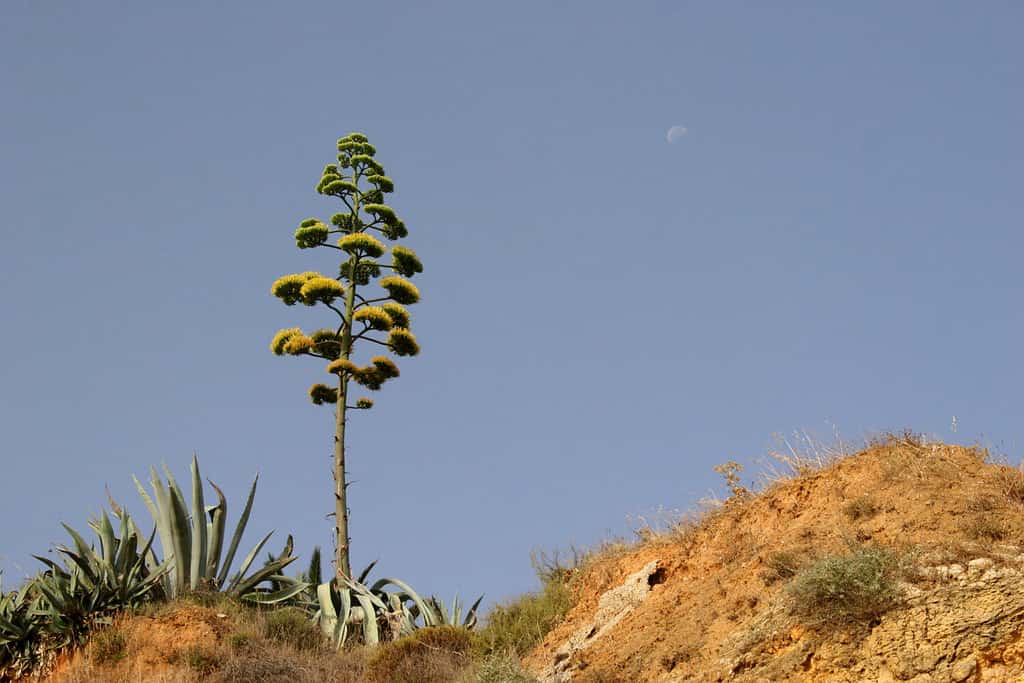
This perennial succulent makes an ideal addition to a drought-tolerant xeriscape.
©Natalka De/Shutterstock.com
Some people may be familiar with agave (Agave spp.) thanks to its entry into the health food world a few decades back. However, agave is far more than just a natural sweetener. This stunning plant also makes an ideal addition to a drought-tolerant xeriscape. It’s a perennial succulent that grows best in zone 9 and warmer. The flower stalk of agave plants ultimately grows to up to 40 feet tall. These desert plants are highly drought-tolerant, so you don’t need to worry too much about maintenance once established.
3. Allegheny Spurge
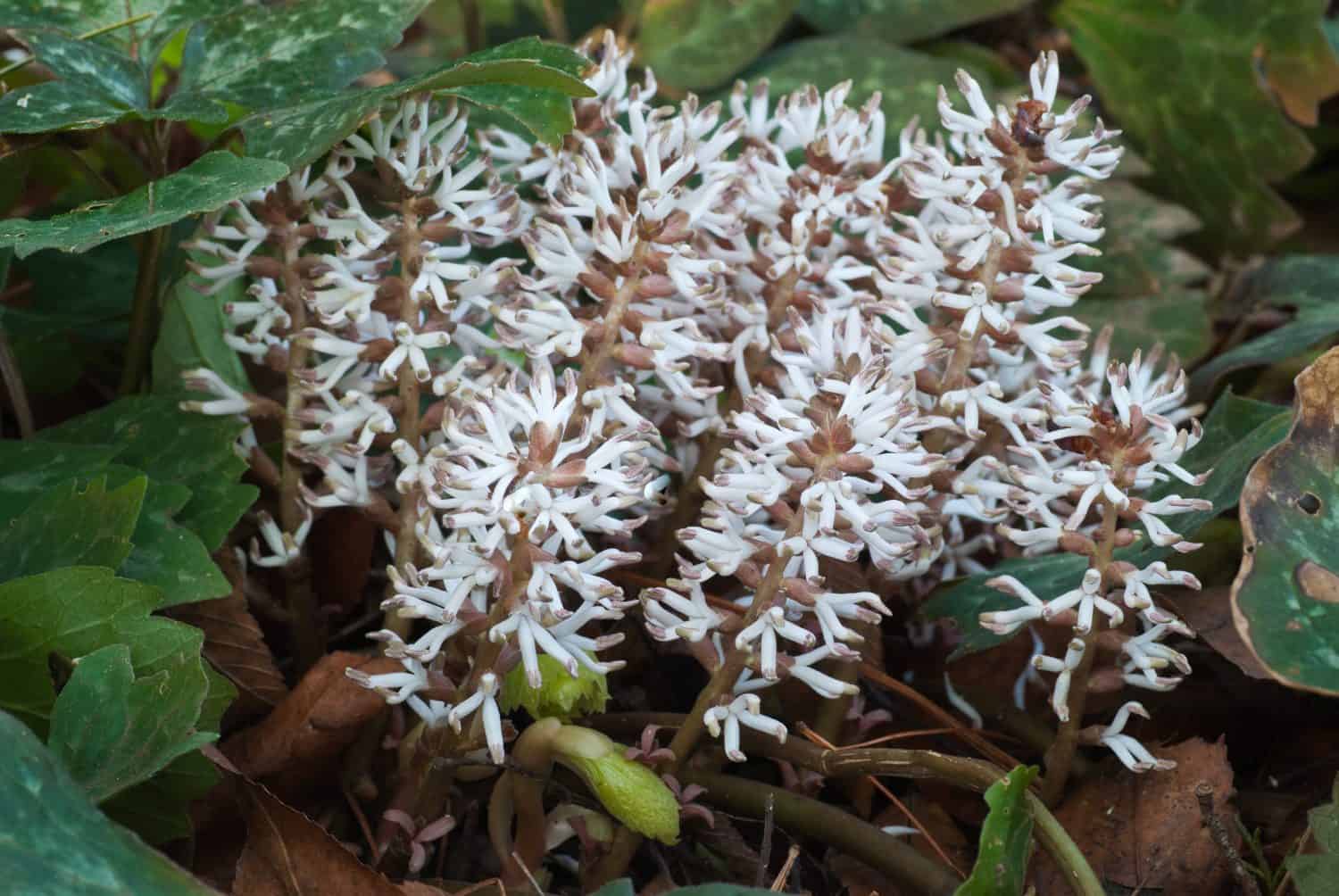
Allegheny spurge is drought-tolerant, but it can also handle deep shade.
©Gerry Bishop/Shutterstock.com
Those looking for something a little smaller may consider a ground cover like Allegheny spurge (Pachysandra procumbens). This herbaceous perennial is native to the southeastern region of the United States and grows best in zones 5 to 9. Not only is this plant drought-tolerant, but it can also handle deep shade. So, you can tuck it into the corners of your garden or yard where nothing else will grow.
4. Anise-Scented Sage

This sage variety is an ideal plant for borders or hedges.
©iStock.com/fpdress
Another member of the Lamiaceae (mint) family is anise-scented sage (Salvia guaranitica), which is native to parts of South America. Like its cousins, this sage variety has significant medicinal properties and plays an important role in traditional medicine. It’s an ideal plant for borders or hedges, and its lovely flowers attract hummingbirds and pollinators. In zones 7 to 11, it gets grown as a perennial but can be a successful annual in cooler regions. While anise-scented sage isn’t drought-tolerant from the start, it will tolerate plenty of heat and drought-like conditions once it gets established.
5. Apache Plume

Apache plume is native to the southwestern United States and produces gorgeous flowers.
©Kathryn Roach/Shutterstock.com
Anyone living in the desert southwest has likely come across the Apache plume (Fallugia paradoxa), which is native to the region. However, you don’t have to be a resident of the desert to plant it in your drought-tolerant xeriscape garden. Apache plume will survive in USDA Hardiness Zones 7 to 11. It is a deciduous shrub that is best planted on sloped areas since it helps prevent erosion. During the spring and summer, it will reward you with gorgeous white flowers.
6. Beavertail Cactus
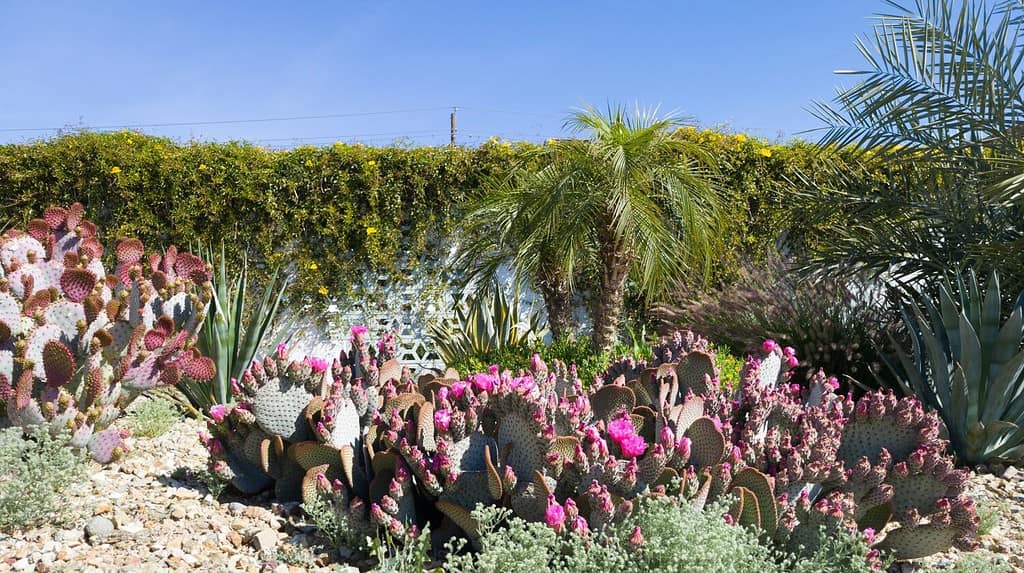
These cacti develop in low clumps.
©You Touch Pix of EuToch/Shutterstock.com
Cacti fans will love the beavertail cactus (Opuntia basilaris). This low-growing plant develops in clumps that are much wider than they are tall. It develops 3-inch magenta flowers in the spring. And, as a member of the prickly pear family, fruit shortly follows the blossoms. Beavertail cacti plants grow best in zones 8 to 10, and are extremely drought-tolerant.
7. Blue Avena Grass

This clumping ornamental grass is deer, drought, and air pollution-tolerant.
©Kathryn Roach/Shutterstock.com
An often-overlooked addition to drought-tolerant xeriscape gardens is grasses. One fantastic option is the blue avena grass (Helictotrichon sempervirens). This clumping ornamental grass is native to parts of Europe and grows best in zones 4 to 8. It is deer, drought, and air pollution-tolerant, so it is suitable for even inner city gardens. Blue avena grass prefers full sun and doesn’t grow larger than around three feet tall and wide.
8. California Tree Poppy

This poppy species can grow up to eight feet tall!
©marineke thissen/Shutterstock.com
The California tree poppy (Romneya coulteri) is a member of the Papaveraceae (poppy) family that produces its magnificent flowers from late spring to early summer. This perennial often grows up to eight feet tall and prefers dry, rocky soil. It thrives in USDA Hardiness zones 8 to 10.
9. Catmint
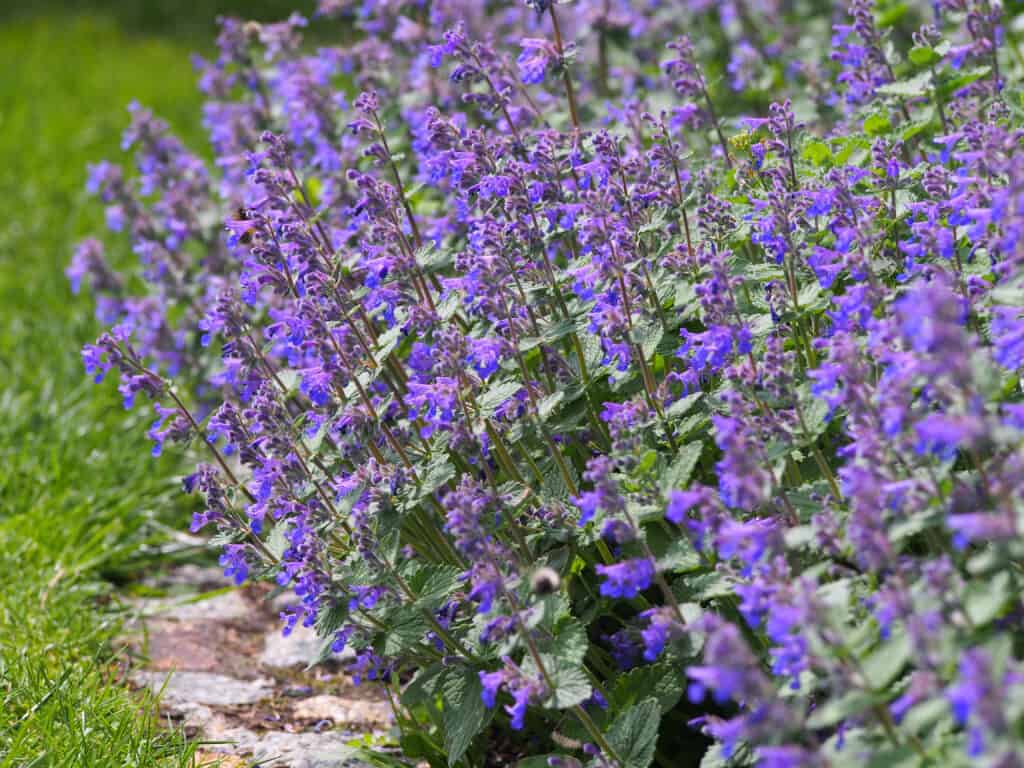
Add this catmint variety to your drought-tolerant xeriscape.
©Anna Gratys/Shutterstock.com
Plant one of the many varieties of catmint (Nepeta spp.) in your drought-tolerant xeriscape for a serious treat. This member of the Lamiaceae (mint) family is a natural insect repellent, so it can help protect your other plants. Additionally, the leaves are edible and often used in traditional medicine. You may need to nurse your plants along at the beginning to help them get established. But once you do, they are highly drought-tolerant. Catmint will happily grow in zones 3 to 8.
10. Desert Spoon
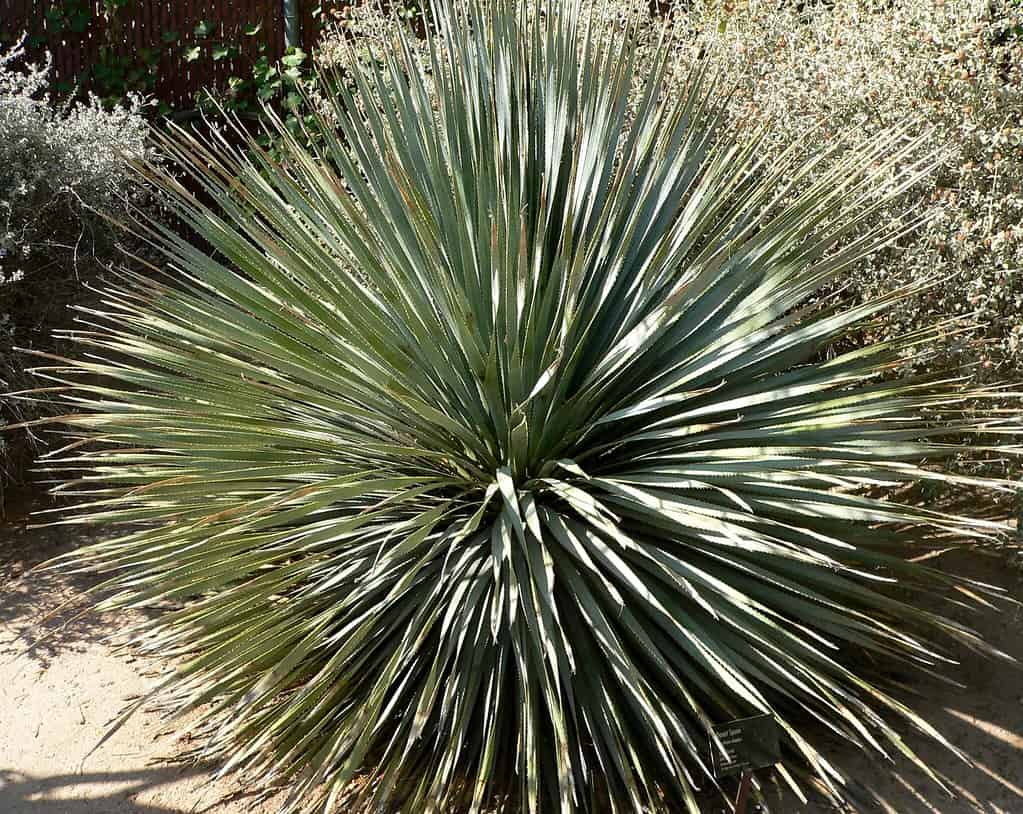
This low-maintenance plant needs full sun and attracts hummingbirds and bees.
©Stan Shebs, CC BY-SA 3.0 , via Wikimedia Commons – Original / License
Desert spoon (Dasylirion wheeleri) makes a fantastic addition to drought-tolerant xeriscapes. This succulent thrives in zones 8 to 11. It grows up to five feet high and wide, so you can count on this plant to take up some serious space in your yard. Desert spoon is a low-maintenance plant that needs full sun and attracts hummingbirds and bees. Plus, it is resistant to nearly everything the world can throw at it. This plant is rabbit-, deer-, dry soil-, and drought-tolerant.
11. Crimson Pygmy Barberry
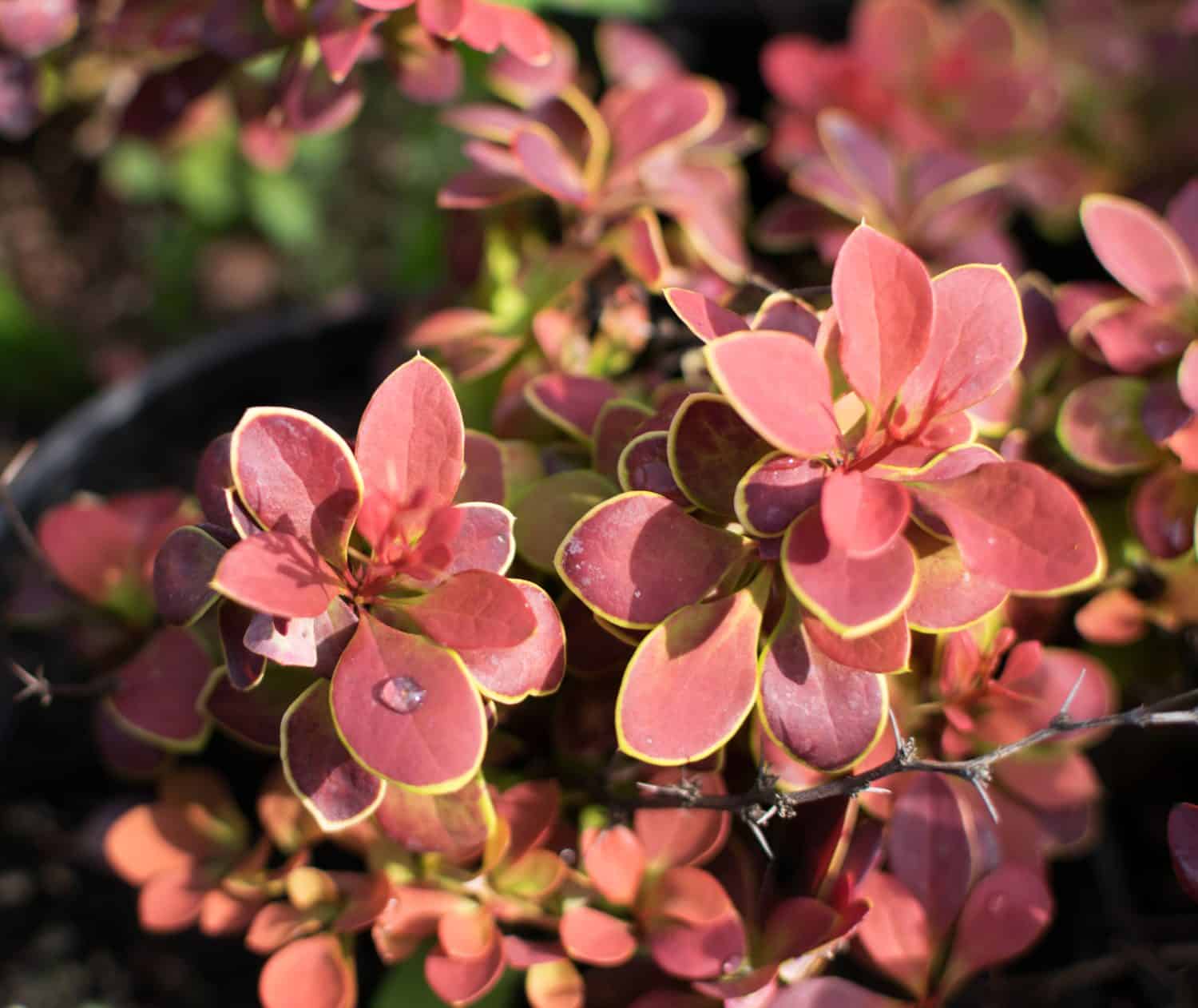
Crimson pygmy barberry lives up to its name with its beautifully crimson foliage.
©Masianya/Shutterstock.com
Due to its compact nature, many people love adding crimson pygmy barberry (Berberis thunbergii ‘Crimson Pygmy’) to their yards. It is low-maintenance and doesn’t have a lot of pest issues. Crimson pygmy barberry grows best in zones 4 to 9 and can tolerate anywhere from full sun to partial shade. However, one word of caution is that it isn’t the best plant to have around kids because of its thorns.
12. False Shamrock
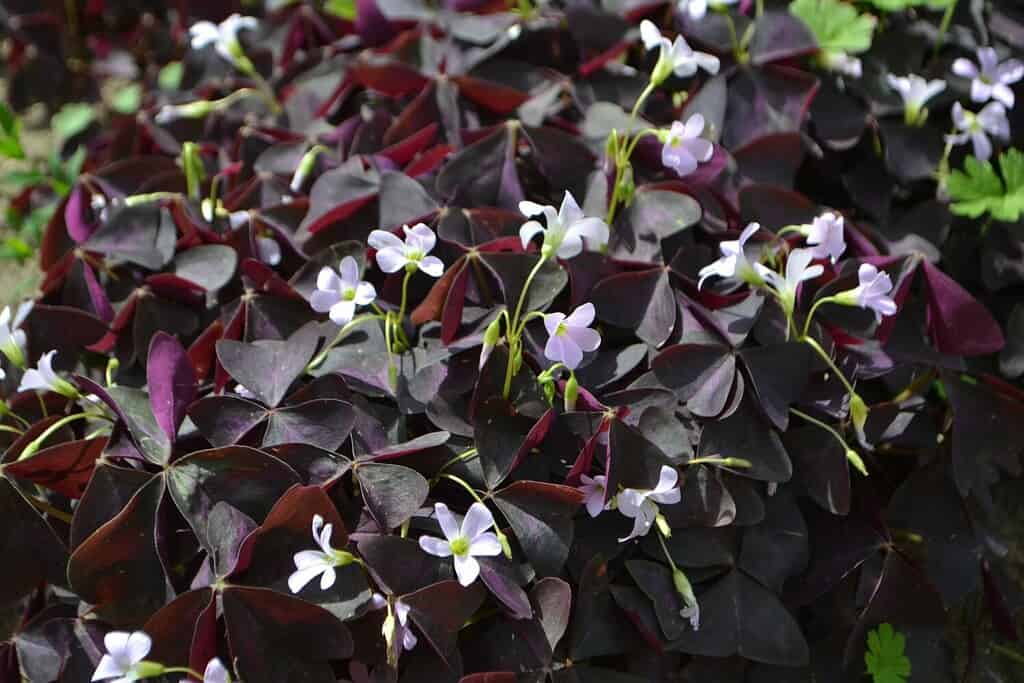
False shamrock
is a stunning addition to any xeriscape space.
©Edita Medeina/Shutterstock.com
Also known as the “purple shamrock” and the “love plant,” the false shamrock (Oxalis triangularis) is a stunning addition to any xeriscape space. This ornamental houseplant is native to South America. It thrives in zones 8 to 11. False shamrock is deer tolerant, attracts pollinators, and can handle dry soil on occasion. While it’s not technically drought-tolerant, it will live through dry spells. What makes this plant so fascinating is its lovely purple leaves close when they get disturbed.
13. Iceplant
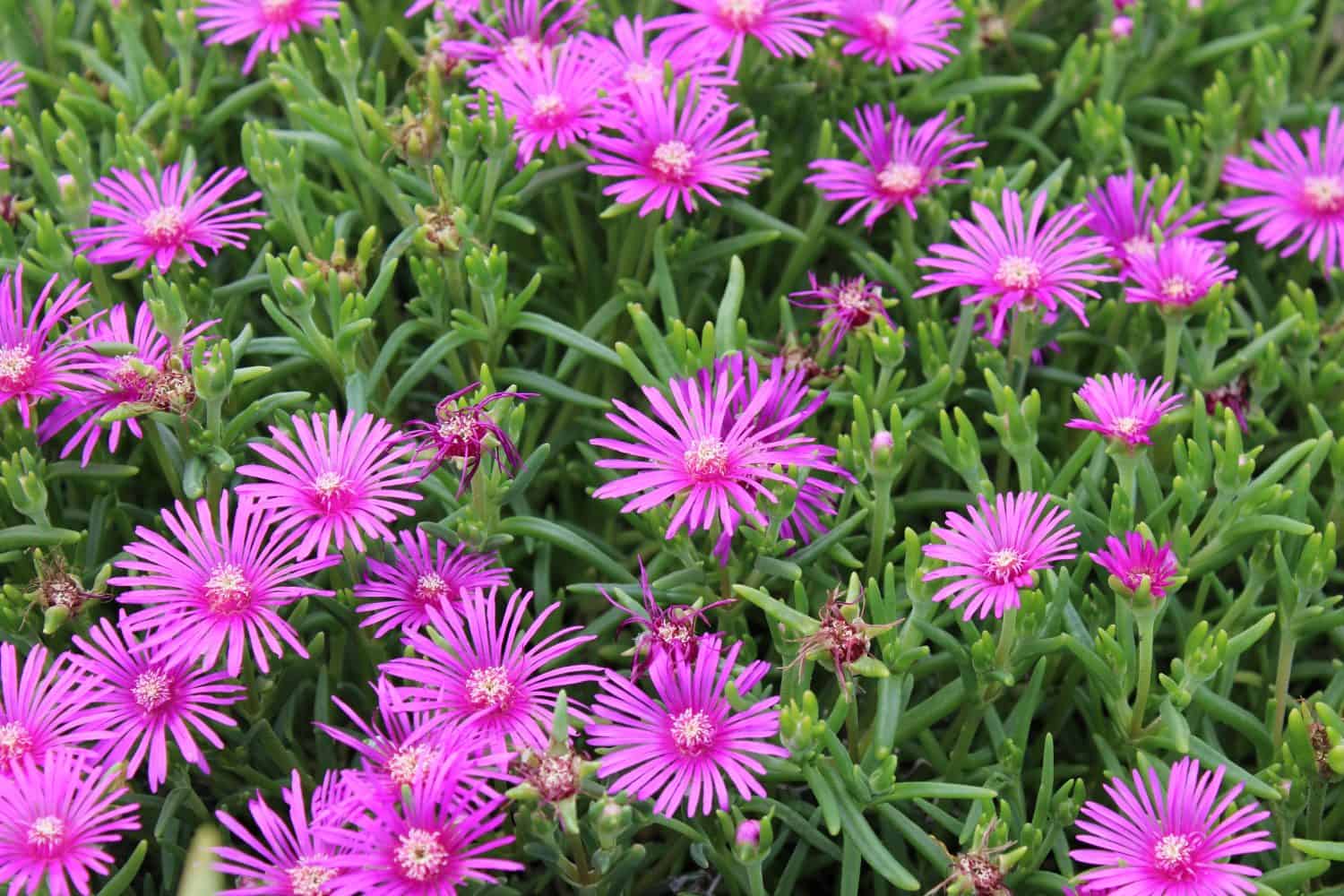
Bees and butterflies flock to iceplants in the summer and fall, thanks to their lovely flowers.
©Tagetes/Shutterstock.com
Iceplants (Delosperma spp.) are native to Africa and belong to the Aizoaceae (fig-marigold) family. They are heat and drought-tolerant and do best in zones 5 to 8. These perennials are fantastic along borders or edges of gardens and offer a beautiful addition to any space. Butterflies and bees love visiting the lovely flowers in the summer and fall.
14. Jelly Bean Plant
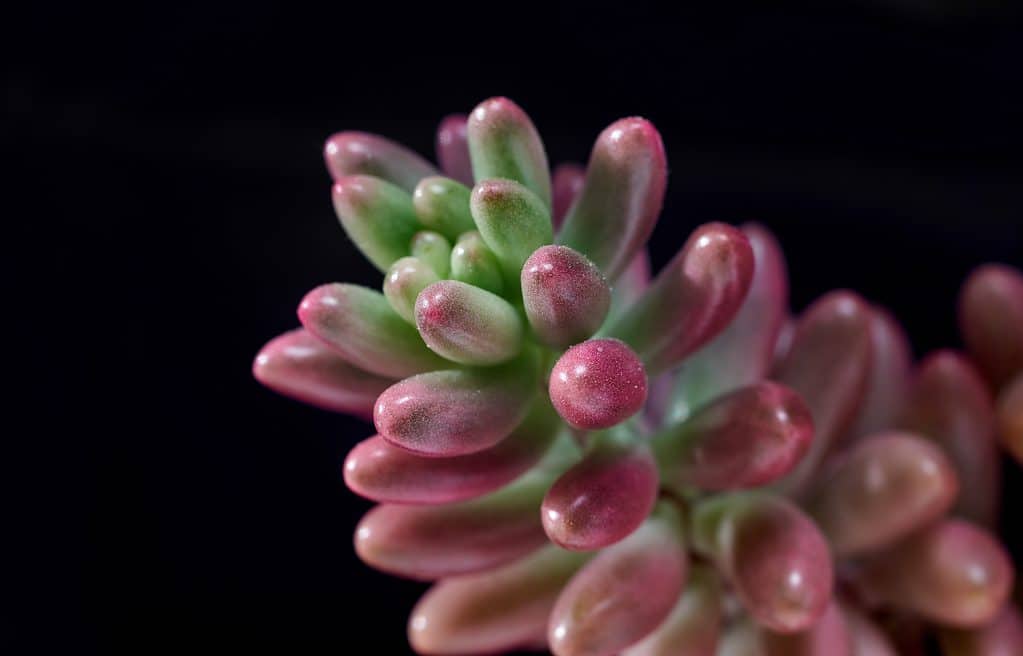
Jelly bean plants have remarkably unique leaves.
©Kateryna Puchka/Shutterstock.com
An interesting succulent to add to drought-tolerant xeriscape gardens is the jelly bean (Sedum rubrotinctum) plant, which thrives in zones 9 to 11. It doesn’t take up much space since it grows less than a foot tall and wide. But it makes up for its small size in “personality.” Its leaves are chubby and resemble jelly beans. And they change colors throughout the year between green and bright red.
15. Lavender
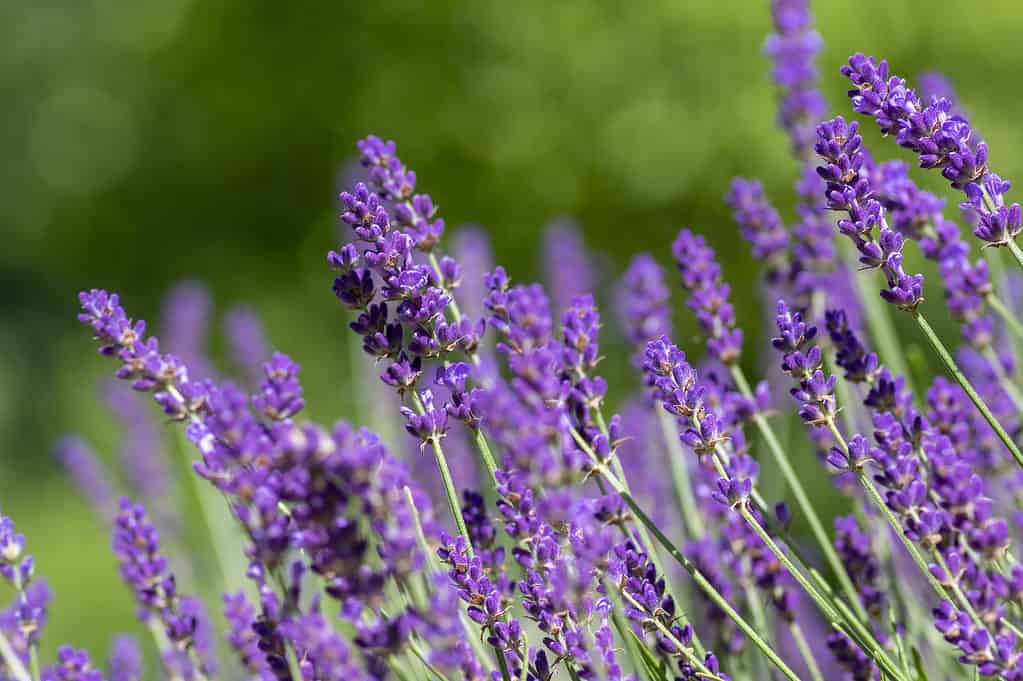
Beautiful lavender is a beautiful addition to any xeriscape garden.
©iStock.com/Iva Vagnerova
This familiar scent is in nearly everything these days, and for good reason. These lovely flowers are highly fragrant and bring an intoxicating aroma to every space. Since they are also drought-tolerant, you can add them to any xeriscaped place. Lavender (Lavandula angustifolia) is a member of the Lamiaceae (mint) family, native to Europe, and grows best in zones 5 to 8. The plants can tolerate rocky and dry soil, deer, droughts, rabbits, and air pollution.
16. Lavender Cotton
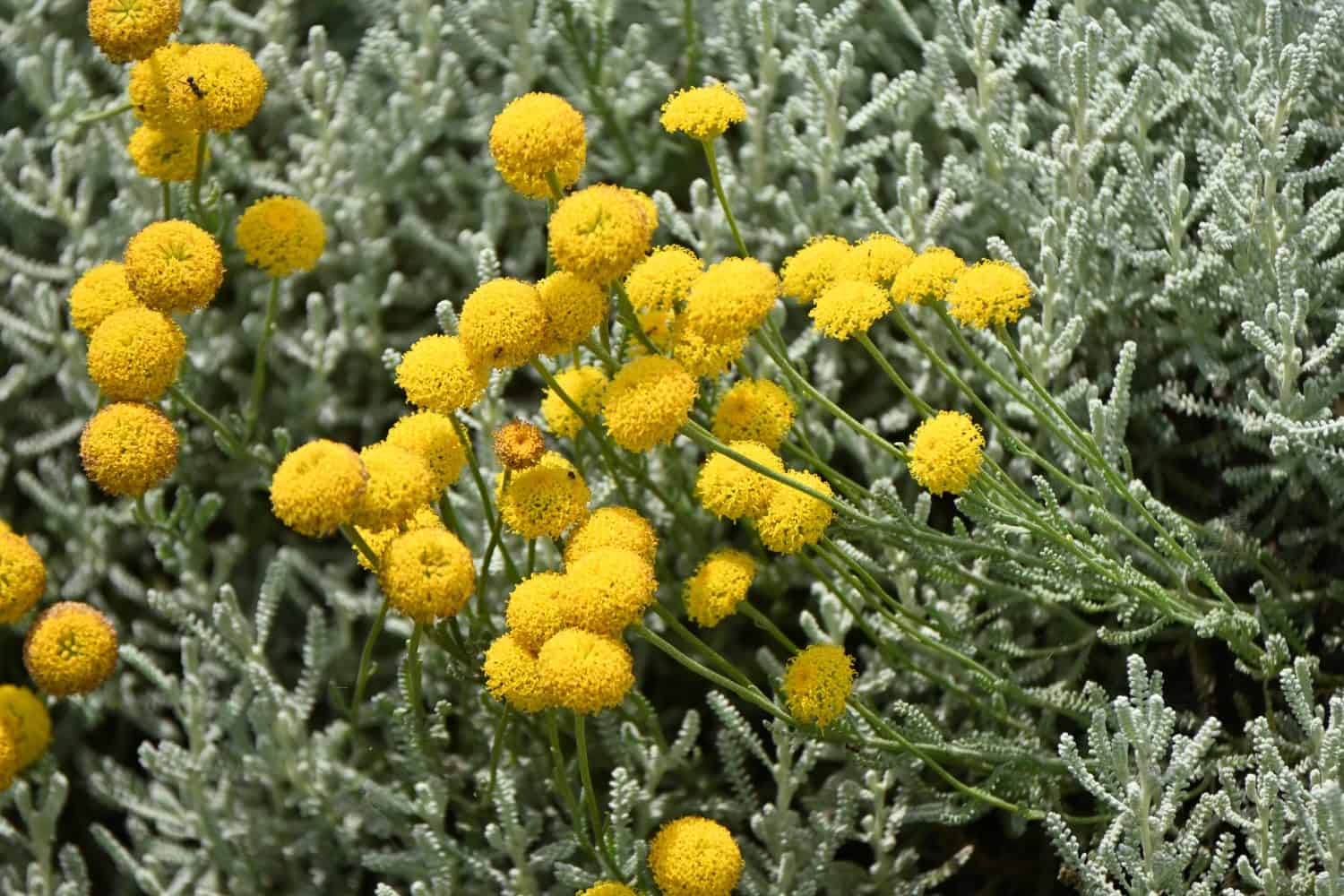
These colorful flowers are ideal for winter interest gardens.
©tamu1500/Shutterstock.com
Despite its name, lavender cotton (Santolina chamaecyparissus) is a member of the Asteraceae (daisy) family, not the mint family. It is native to the Mediterranean region and grows best in zones 6 to 9. Lavender cotton grows up to two feet tall and three feet wide. It has colorful flowers and fragrant leaves. This unique plant is also the perfect winter interest option for your space.
17. Mexican Feather Grass
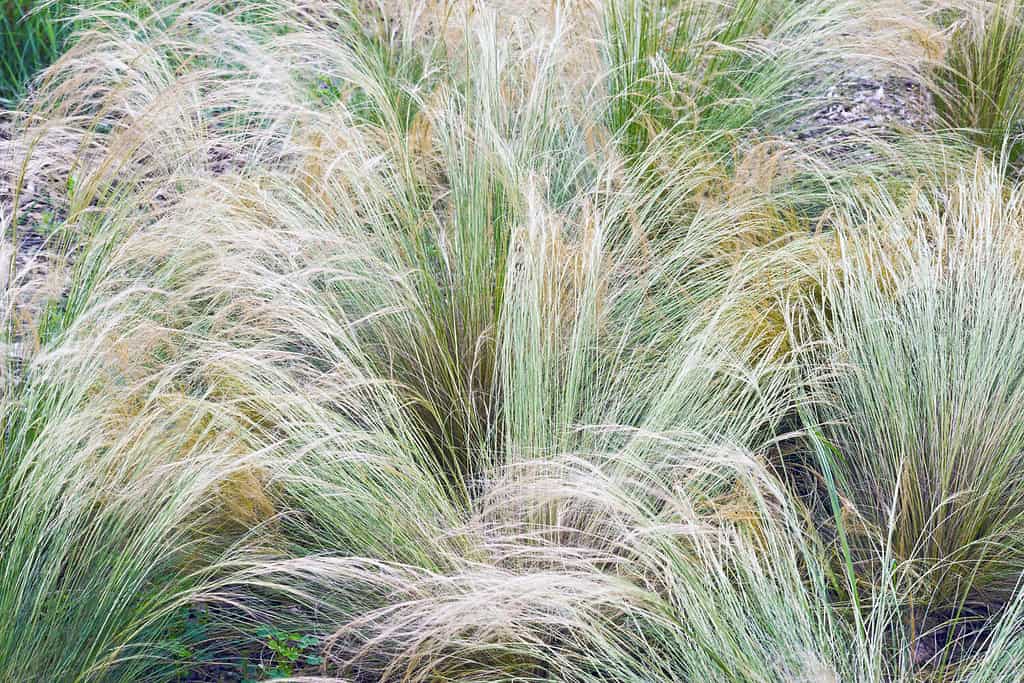
You can plant Mexican feather grass nearly everywhere.
©Beach Creatives/Shutterstock.com
One of the top ornamentals you can add to your yard or garden is the Mexican feather grass (Nassella tenuissima). This stunning plant is drought-tolerant and resistant to different soil qualities, deer, and erosion. Mexican feather grass does well in full sun to partial shade, so you can plant it nearly anywhere. It grows best in zones 7 to 10.
18. Mojave Sage
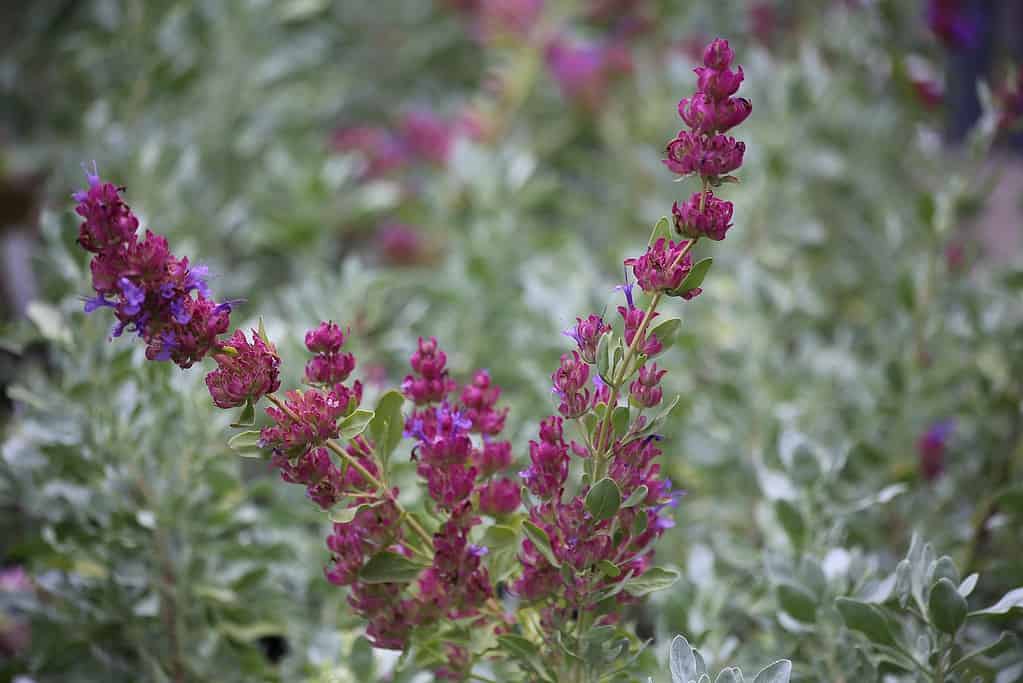
Mojave sage is an evergreen shrub native to the desert southwest.
©The Friends of Manito, Public domain, via Wikimedia Commons – Original / License
The long bloom time of Mojave sage (Salvia pachyphylla) makes it perfect for xeriscape spaces. It is an evergreen shrub native to the desert southwest. Mojave sage requires full sun but is otherwise low-maintenance. This low-growing plant rarely grows to over two feet tall. It flowers from summer through fall. Plant this shrub in any growing zone from 6, warmer.
19. Panchito Manzanita
A slightly unusual plant that is perfect for xeriscape spaces is Panchito manzanita (Arctostaphylos x coloradoensis ‘Panchito’). It is low-growing and needs very little water. It only reaches thirty-six inches wide and fifteen inches tall at maturity. This plant is native to the southwestern United States and grows best in zones 4 to 8.
20. Pinon Pine

Pinon trees grow delicious pinon nuts.
©iStock.com/Ana Iacob
You don’t need to stick to low-growing plants in your xeriscape garden. One option for a larger plant is pinon pine (Pinus edulis). It’s an evergreen native to the southwestern United States. While these trees need full sun, they also tolerate rocky or sandy soil. Pinon pines grow best in zones 6 to 8. They also develop lovely flowers in the spring and fruits in the fall.
21. Purple Poppy-Mallow

The purple poppy mallow is part of the mallow family and a perfect addition to the xeriscape garden.
©iStock.com/RukiMedia
A stunning option for your xeriscape space is the purple poppy mallow (Callirhoe involucrata). This herbaceous perennial is native to the central United States. It grows up to a foot high and three feet wide. Purple poppy-mallow is a low-maintenance plant that requires full sun and little water. Feel free to plant it in poor or rocky soil, where it will thrive.
Summary of 21 Plants Perfect for Drought-Tolerant Xeriscapes
| Common Name | Scientific Name | USDA Growing Zones |
|---|---|---|
| Agastache | Agastache spp. | 5 to 10 |
| Agave | Agave spp. | 9 to 11 |
| Allegheny Spurge | Pachysandra procumbens | 5 to 9 |
| Anise-Scented Sage | Salvia guaranitica | 7 to 11 |
| Apache Plume | Fallugia paradoxa | 7 to 10 |
| Beavertail Cactus | Opuntia basilaris | 8 to 10 |
| Blue Avena Grass | Helictotrichon sempervirens | 4 to 8 |
| California Tree Poppy | Romneya coulteri | 8 to 10 |
| Catmint | Nepeta spp. | 3 to 8 |
| Desert Spoon | Dasylirion wheeleri | 8 to 11 |
| Crimson Pygmy Barberry | Berberis thunbergii ‘Crimson Pygmy’ | 4 to 9 |
| False Shamrock | Oxalis triangularis | 8 to 11 |
| Iceplant | Delosperma spp. | 5 to 8 |
| Jelly Bean Plant | Sedum rubrotinctum | 9 to 11 |
| Lavender | Lavandula angustifolia | 5 to 8 |
| Lavender Cotton | Santolina chamaecyparissus | 6 to 9 |
| Mexican Feather Grass | Nassella tenuissima | 7 to 10 |
| Mojave Sage | Salvia pachyphylla | 6 to 11 |
| Panchito Manzanita | Arctostaphylos x coloradoensis ‘Panchito’ | 4 to 8 |
| Pinon Pine | Pinus edulis | 6 to 8 |
| Purple Poppy-Mallow | Callirhoe involucrata | 4 to 8 |
The photo featured at the top of this post is © gardendata/ via Getty Images
Thank you for reading! Have some feedback for us? Contact the AZ Animals editorial team.







